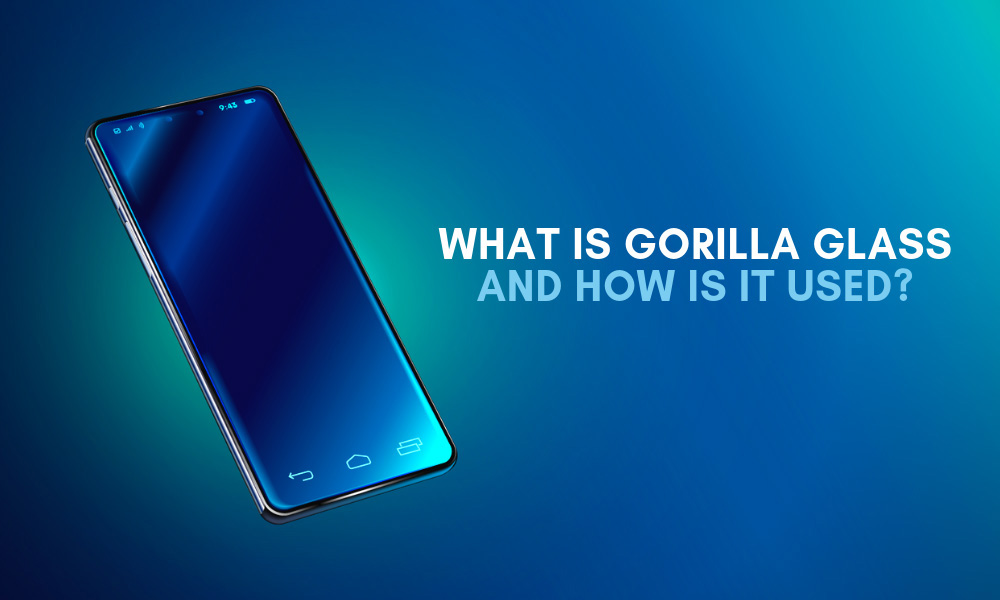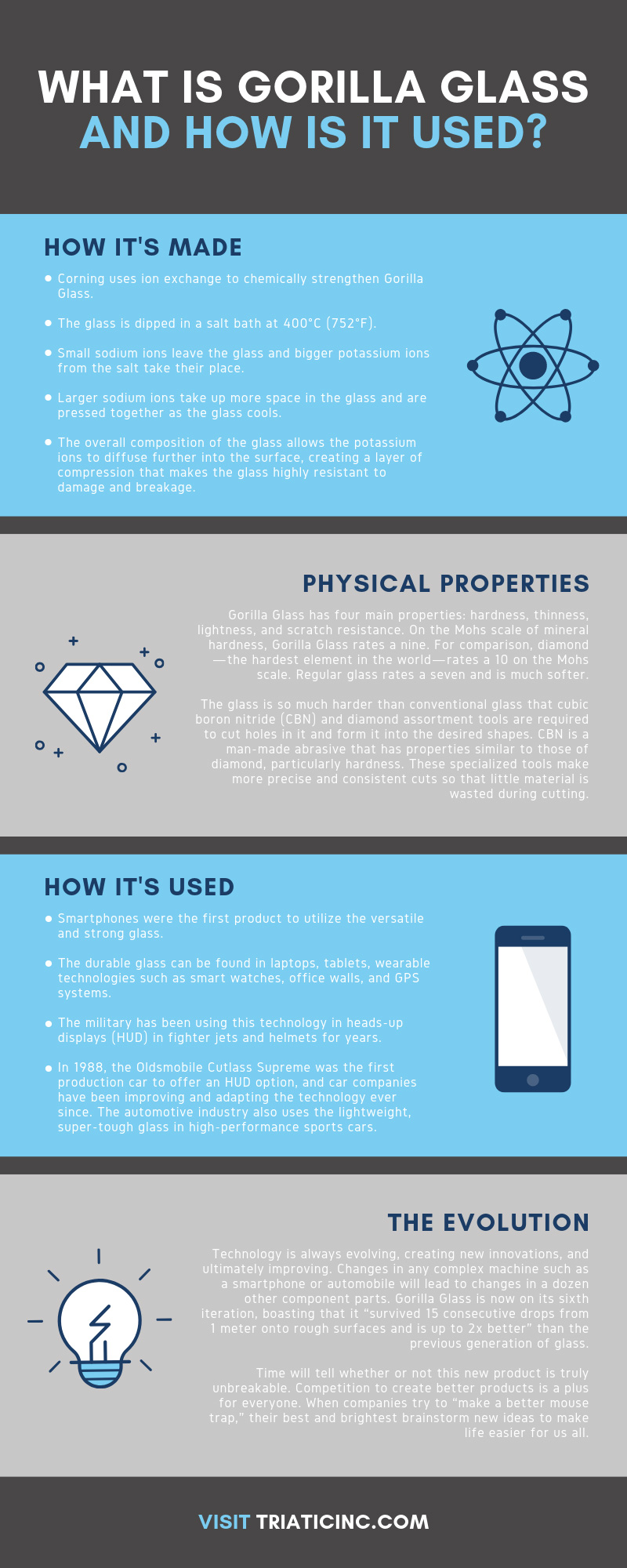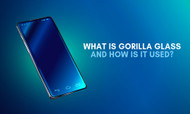What is Gorilla Glass and How is it Used?
24th Oct 2023

Gorilla Glass is a brand name that Corning Inc. uses for its strengthened, tempered glass. Gorilla Glass was designed to be lightweight, thin, and resistant to damage that would cause normal glass to crack or break. In 1960, Corning initiated Project Muscle with the goal of creating a chemically strengthened glass. After a few years of experiments and trials, they came up with Chemcor. It was significantly stronger than glass, and they thought it could be used for phone booths, eyeglasses, and cars. The product was moderately successful, but Corning tabled it when sales slowed. Ultimately, it was a solution in search of a problem.
In 2005, Steve Jobs came to Corning with that problem. He wanted millions of square feet of an ultra-strong, ultra-thin glass for his revolutionary product, the iPhone. Corning dusted off their Chemcor samples, renamed the product Gorilla Glass—and the rest is history. Gorilla Glass is now used by nearly every major smartphone maker in the world. Worldwide, there are now 2.7 billion smartphone users, 10 billion mobile devices in use, and 14 million jobs directly related to the smartphone industry. We may not even realize it, but Gorilla Glass is certainly indispensable in our daily lives.
How Gorilla Glass is Made
Corning uses ion exchange to chemically strengthen Gorilla Glass by stuffing it with large ions, which creates state of compression. The glass is dipped in a salt bath at 400 degrees Celsius (752 degrees Fahrenheit). In the bath, small sodium ions leave the glass and bigger potassium ions from the salt take their place. The larger sodium ions take up more space in the glass and are pressed together as the glass cools, yielding a layer of compressive stress on the glass. The overall composition of the glass allows the potassium ions to diffuse further into the surface, creating a layer of compression that makes the glass highly resistant to damage and breakage.
Physical Properties of Gorilla Glass
Gorilla Glass has four main properties: hardness, thinness, lightness, and scratch resistance. On the Mohs scale of mineral hardness, Gorilla Glass rates a nine. For comparison, diamond—the hardest element in the world—rates a 10 on the Mohs scale. Regular glass rates a seven and is much softer.
The properties that make Gorilla Glass desirable—especially the hardness—can create problems cutting the glass down to usable sizes. Large sheets of the glass are delivered to production facilities, and it’s up to them to cut the sheets into specific dimensions for their products. The glass is so much harder than conventional glass that cubic boron nitride (CBN) and diamond assortment tools are required to cut holes in it and form it into the desired shapes. Cubic boron nitride is a man-made abrasive that has properties similar to those of diamond, particularly hardness. Electroplated diamond and CBN contour tools are used to cut the slots in smartphone glass so that you can speak and hear clearly. Diamond grinding wheels are also used to round edges and remove any burrs or imperfections in the glass so that it will fit the phone cleanly. These specialized tools make more precise and consistent cuts so that little material is wasted during cutting.
How it’s Used
Smartphones were the first product to utilize the versatile and strong glass, but new uses have been found for it since. The durable glass can be found in laptops, tablets, wearable technologies such as smart watches, office walls, and GPS systems. The uses for it are ever-expanding.
In many instances, the military gets the latest and greatest tech ahead of the civilian world, and the heads-up display was no exception. They have been using heads-up displays (HUD) in fighter jets and helmets for years. Once the technology was declassified and made more widely available, the automotive industry took advantage.
In 1988, the Oldsmobile Cutlass Supreme was the first production car to offer an HUD option, and car companies have been improving and adapting the technology ever since. In the early days, the HUD was projected from the dashboard onto the windshield or onto a separate, smaller pane of glass. It was visible only to the driver. Nowadays, there is a laminated inner layer of glass with phosphorescent molecules that glow red, green, or blue when illuminated by an ultraviolet projector. Next-generation HUDs also provide more information, such as road conditions, projecting it from within the windshield but focusing the driver’s vision from two to 10 yards in front of the vehicle. Drivers favor HUD because it allows them to keep their eyes on the road.
The automotive industry also uses the lightweight, super-tough glass in high-performance sports cars. Using Gorilla Glass over conventional glass lowers the overall weight of the car, helping it achieve higher speeds. Lightweight windows also help cars meet carbon emission standards and get better gas mileage, making the car more efficient and environmentally friendly.
The Evolution of Gorilla Glass
Technology is always evolving, creating new innovations, and ultimately improving. Changes in any complex machine such as a smartphone or automobile will lead to changes in a dozen other component parts. Gorilla Glass is now on its sixth iteration, boasting that it “survived 15 consecutive drops from 1 meter onto rough surfaces and is up to 2x better” than the previous generation of glass.
Competition has also arisen from the success of Gorilla Glass, with competitors such as Japan’s AGC Inc. producing similar “unbreakable” products in the hopes of taking their share of the marketplace. Samsung has developed what they are calling an unbreakable screen, which has been certified by Underwriters Laboratories. Time will tell whether or not this new product is truly unbreakable. Consumers generally test any new tech to the fullest within the first few days of its introduction; they want to know how it works and if it does what it’s supposed to. Competition to create better products is a plus for everyone. When companies try to “make a better mouse trap,” their best and brightest brainstorm new ideas to make life easier for us all.


